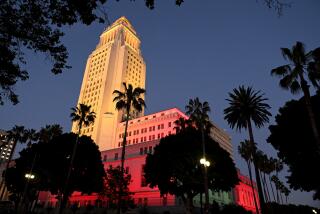Quirk in City Law: The Dead Can Legislate : Council: Under the rules, three deceased members have matters awaiting decision.
- Share via
Dead men tell no tales, but in Los Angeles, at least they can legislate.
That was demonstrated Tuesday by Howard Finn, the former councilman who died in 1986.
A routine motion filed by Finn in 1983 was unanimously approved by the City Council on Tuesday, without debate and without any apparent concerns about the status of the motion’s author.
Through a quirk in city law, council motions stay current and pending until they are passed, defeated or filed--no matter how long it takes.
And some have a very long wait. At least nine former council members, including three who are dead, still have dozens of motions pending. In all, records show, there are more than 1,200 motions pending before the City Council, with hundreds more than 5 years old and dozens more than 10 years old.
Finn’s motion, which would limit the length of trucks allowed on city streets to 65 feet, languished in the City Council for three years before he died in office.
Councilman Hal Bernson, who seconded Finn’s motion eight years ago, said he was unaware that it was one of dozens of items routinely approved Tuesday and added that he did not recall its original purpose.
“It must have sounded like a good idea at the time,” he said with a smile.
Indeed, there are apparently plenty of other “good ideas” waiting for council attention.
Some date to the 1970s, including a 1975 motion by the late Councilman John S. Gibson Jr. seeking to eliminate the city’s Board of Public Works. Gibson left the council in 1981 and died in 1987.
Unresolved is a 1975 motion by then-Councilman Art Snyder seeking to annex the unincorporated area of East Los Angeles. A 1987 motion by then-Councilwoman Pat Russell to close an alley at 85th Street is still awaiting a vote by the Transportation Committee.
Then-Councilwoman Peggy Stevenson proposed in 1979 that the Recreation and Parks Department report directly to the mayor and council. In 1984, then-Councilman Robert Farrell proposed an ordinance requiring public restrooms at gas stations and mini-markets. Both measures remain on the council docket.
Farrell and Supervisor Gloria Molina, who left the council in March, have more pending motions before the body than any other former council members.
Though old, not all the pending legislation has lost its timeliness. A 1982 motion by then-Councilman Dave Cunningham asks the Police Commission to fire Police Chief Daryl F. Gates--an idea that gathered some support during this year’s Rodney G. King controversy.
Cunningham, who left the council in 1985, said he was unaware that any of his motions remained active.
Unlike Congress or the state Assembly and Senate, where unpassed bills die at the close of a legislative session, council motions can live on indefinitely.
But now there is a move to limit the life span of legislation.
In September, Council President John Ferraro asked the city clerk, city attorney and chief legislative analyst for reports on how orphaned or aging council motions can be cleared from the books.
“I personally send out notices of the files to all committee chairman monthly” asking them to clear out the most aged items, said Ferraro. “It’s expensive to keep these files alive.” The city clerk had no precise figures on how much it costs to maintain the files.
Though Ferraro is leading the way to change the system, he acknowledged the process does have its good points.
In the case of Finn’s motion regulating the size of trucks, Ferraro noted that there was industry opposition to the matter in 1983. “I guess we waited them out,” Ferraro said jokingly after the motion passed without comment.
Councilman Nate Holden, chairman of the council’s Transportation Committee that brought Finn’s motion to the floor Tuesday, said that “once (motions) hang around that long they are dead.”
But regulations restricting trucks are like “motherhood,” Holden said, adding that they always receive an aye vote at the council. And besides, Holden said, “It won’t do any harm.”
Given the volume of council motions and the cumbersome process for dispensing with them, it is no wonder so many get left on the shelf.
On Tuesday for example, the council agenda included 84 items, and a dozen new motions were filed. The city administrative officer prepares between 3,000 and 4,000 reports annually in response to council motions. Most of the pending motions, even the aging ones, were authored by current council members.
Ideas that initially grabbed headlines, but were slow to gather support on the council include a 1986 a motion by Councilman Zev Yaroslavsky to enact a “no-more-slow-play” program at city golf courses.
Cunningham co-authored, with the late Gilbert Lindsay, a 1984 measure to tighten restrictions against illegal dumping on vacant lots. “We still need that,” Cunningham said. “I still call City Hall all the time about that.”
Many motions will have to make several trips to the council before they are finalized.
Finn’s motion, for instance, called for the city attorney to write an ordinance. So, it will have to return to the Transportation Committee and the full council at least one more time before it can be put to rest.
Old Motions Won’t Fade Away
Due to a quirk in Los Angeles law, several former City Council members, including three who are dead, have legislation pending. Dozens of their proposals remain active among more than 1,200 council motions.
Peggy Stevenson: Left council in 1985
Robert C. Farrell: Left council in 1991
Pat Russell: Left council in 1987
Arthur K. Snyder: Left council in 1985
David Cunningham: Left office in 1987
John S. Gibson Jr.: Left council in 1981; Died in 1987
Howard Finn: Died in office in 1986
Gilbert Lindsay: Died in office in 1990
More to Read
Sign up for Essential California
The most important California stories and recommendations in your inbox every morning.
You may occasionally receive promotional content from the Los Angeles Times.













